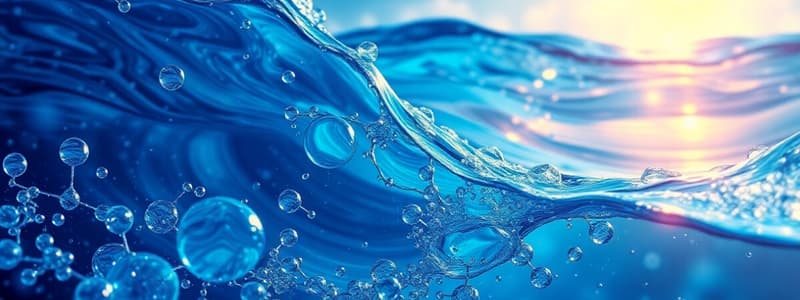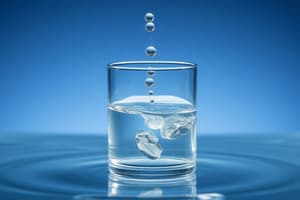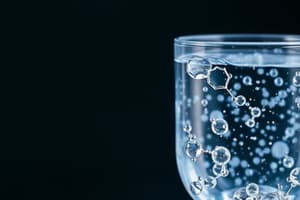Podcast
Questions and Answers
What is the shape of a water molecule?
What is the shape of a water molecule?
- Planar
- Cubic
- Linear
- Bent or V-shaped (correct)
What property of water allows it to support small insects on its surface?
What property of water allows it to support small insects on its surface?
- High surface tension (correct)
- Low temperature conductivity
- High density
- High boiling point
What causes the universal solvent property of water?
What causes the universal solvent property of water?
- Its dipole nature (correct)
- Its high density
- Its non-polar nature
- Its viscous flow
How many hydrogen bonds can a single water molecule form?
How many hydrogen bonds can a single water molecule form?
Why is solid water (ice) less dense than liquid water?
Why is solid water (ice) less dense than liquid water?
The polar nature of water molecules is primarily due to what characteristic?
The polar nature of water molecules is primarily due to what characteristic?
Which unique property of water facilitates diverse ocean chemistry?
Which unique property of water facilitates diverse ocean chemistry?
What contributes to water's high surface tension?
What contributes to water's high surface tension?
What is the primary reason ice floats on water?
What is the primary reason ice floats on water?
How does water's high heat capacity contribute to climate stability?
How does water's high heat capacity contribute to climate stability?
What role does the latent heat of vaporization play in weather systems?
What role does the latent heat of vaporization play in weather systems?
What is the Principle of Constant Proportions concerning ocean salinity?
What is the Principle of Constant Proportions concerning ocean salinity?
How does heat transport by oceans affect global climate?
How does heat transport by oceans affect global climate?
Which of the following best describes a key implication of the Principle of Constant Proportions?
Which of the following best describes a key implication of the Principle of Constant Proportions?
What happens to solar heat absorbed by oceans near the equator?
What happens to solar heat absorbed by oceans near the equator?
Why is the concept of high heat capacity essential for life on Earth?
Why is the concept of high heat capacity essential for life on Earth?
What do phytoplankton release as a byproduct during photosynthesis?
What do phytoplankton release as a byproduct during photosynthesis?
During respiration, marine organisms consume which gas?
During respiration, marine organisms consume which gas?
What role do decomposers play in the ocean biological processes?
What role do decomposers play in the ocean biological processes?
How does nutrient recycling benefit phytoplankton growth?
How does nutrient recycling benefit phytoplankton growth?
What is the primary impact of the biological pump on carbon in the ocean?
What is the primary impact of the biological pump on carbon in the ocean?
Where does photosynthesis primarily occur in the ocean?
Where does photosynthesis primarily occur in the ocean?
What happens to oxygen levels during the decomposition process in the ocean?
What happens to oxygen levels during the decomposition process in the ocean?
Which nutrients do phytoplankton uptake during photosynthesis?
Which nutrients do phytoplankton uptake during photosynthesis?
What is primarily responsible for the higher concentration of CO₂ in high-latitude waters?
What is primarily responsible for the higher concentration of CO₂ in high-latitude waters?
Which of the following describes the vertical pattern of salinity in the ocean?
Which of the following describes the vertical pattern of salinity in the ocean?
Where are oxygen minimum zones (OMZs) commonly found?
Where are oxygen minimum zones (OMZs) commonly found?
What do well-mixed polar waters generally exhibit in terms of O₂ levels?
What do well-mixed polar waters generally exhibit in terms of O₂ levels?
How does salinity vary horizontally in the ocean?
How does salinity vary horizontally in the ocean?
What primarily influences the temperature of ocean water at various depths?
What primarily influences the temperature of ocean water at various depths?
Which statement about the deep ocean's salinity is true?
Which statement about the deep ocean's salinity is true?
What effect do warm currents have on sea surface temperature (SST)?
What effect do warm currents have on sea surface temperature (SST)?
What is the Carbonate Compensation Depth (CCD)?
What is the Carbonate Compensation Depth (CCD)?
Which factors contribute to the dissolution of calcium carbonate in seawater?
Which factors contribute to the dissolution of calcium carbonate in seawater?
What type of sediments accumulate above the Carbonate Compensation Depth?
What type of sediments accumulate above the Carbonate Compensation Depth?
In which regions are siliceous oozes primarily found?
In which regions are siliceous oozes primarily found?
How do ocean currents influence the distribution of sediments?
How do ocean currents influence the distribution of sediments?
What happens to calcareous sediments below the Carbonate Compensation Depth?
What happens to calcareous sediments below the Carbonate Compensation Depth?
What role does CO₂ concentration play in the dissolution of calcium carbonate?
What role does CO₂ concentration play in the dissolution of calcium carbonate?
What is the main reason for the accumulation of calcareous sediments on the seafloor above the CCD?
What is the main reason for the accumulation of calcareous sediments on the seafloor above the CCD?
What type of waves travel in water depths greater than half their wavelength?
What type of waves travel in water depths greater than half their wavelength?
Which factor predominantly controls the speed of shallow water waves?
Which factor predominantly controls the speed of shallow water waves?
In what type of waves does particle motion become more flattened as the depth decreases?
In what type of waves does particle motion become more flattened as the depth decreases?
What process describes the increase in wave height as waves move from deep to shallow water?
What process describes the increase in wave height as waves move from deep to shallow water?
Which of the following is NOT true about wave refraction?
Which of the following is NOT true about wave refraction?
What characterizes particle motion in shallow water waves?
What characterizes particle motion in shallow water waves?
What happens to waves when their height-to-wavelength ratio exceeds 1:7?
What happens to waves when their height-to-wavelength ratio exceeds 1:7?
What is constructive interference when waves interact?
What is constructive interference when waves interact?
Flashcards
What is the structure of a water molecule?
What is the structure of a water molecule?
A water molecule (H2O) consists of two hydrogen atoms covalently bonded to one oxygen atom. The oxygen atom has a partial negative charge, while the hydrogen atoms have partial positive charges, making it a polar molecule.
What is hydrogen bonding?
What is hydrogen bonding?
Hydrogen bonds occur when the slightly positive hydrogen atom of one water molecule is attracted to the slightly negative oxygen atom of another water molecule. This creates a strong, interconnected network between water molecules.
How do the structure and bonding of water explain its unique properties?
How do the structure and bonding of water explain its unique properties?
Water's unique properties, such as high surface tension, its ability to dissolve substances, and its unusual density behavior, are all directly influenced by the polarity of water molecules and their ability to form hydrogen bonds.
What is surface tension?
What is surface tension?
Signup and view all the flashcards
What is the importance of surface tension?
What is the importance of surface tension?
Signup and view all the flashcards
Why is water called a universal solvent?
Why is water called a universal solvent?
Signup and view all the flashcards
Why is ice less dense than liquid water?
Why is ice less dense than liquid water?
Signup and view all the flashcards
What is the importance of ice being less dense than water?
What is the importance of ice being less dense than water?
Signup and view all the flashcards
High Heat Capacity of Water
High Heat Capacity of Water
Signup and view all the flashcards
How does water's high heat capacity affect climate?
How does water's high heat capacity affect climate?
Signup and view all the flashcards
Heat Transport in Oceans
Heat Transport in Oceans
Signup and view all the flashcards
Latent Heat of Water
Latent Heat of Water
Signup and view all the flashcards
Principle of Constant Proportions
Principle of Constant Proportions
Signup and view all the flashcards
Implications of the Principle of Constant Proportions
Implications of the Principle of Constant Proportions
Signup and view all the flashcards
Salinity
Salinity
Signup and view all the flashcards
Major Dissolved Ions in Seawater
Major Dissolved Ions in Seawater
Signup and view all the flashcards
Photosynthesis in the Ocean
Photosynthesis in the Ocean
Signup and view all the flashcards
Respiration in the Ocean
Respiration in the Ocean
Signup and view all the flashcards
Decomposition in the Ocean
Decomposition in the Ocean
Signup and view all the flashcards
Nutrient Recycling in the Ocean
Nutrient Recycling in the Ocean
Signup and view all the flashcards
The Biological Pump
The Biological Pump
Signup and view all the flashcards
How Seawater Becomes Salty
How Seawater Becomes Salty
Signup and view all the flashcards
The Interconnectedness of N, P, CO2, and O2 in the Ocean
The Interconnectedness of N, P, CO2, and O2 in the Ocean
Signup and view all the flashcards
Salinity of Seawater
Salinity of Seawater
Signup and view all the flashcards
What is the Carbonate Compensation Depth (CCD)?
What is the Carbonate Compensation Depth (CCD)?
Signup and view all the flashcards
What factors control the dissolution of calcium carbonate in seawater?
What factors control the dissolution of calcium carbonate in seawater?
Signup and view all the flashcards
If calcareous ooze is dissolving, how can calcareous sediments accumulate on the seafloor?
If calcareous ooze is dissolving, how can calcareous sediments accumulate on the seafloor?
Signup and view all the flashcards
What is the halocline?
What is the halocline?
Signup and view all the flashcards
What is the thermocline?
What is the thermocline?
Signup and view all the flashcards
What are oxygen minimum zones (OMZs)?
What are oxygen minimum zones (OMZs)?
Signup and view all the flashcards
What are some characteristics of polar and upwelling regions in terms of nutrients and CO2?
What are some characteristics of polar and upwelling regions in terms of nutrients and CO2?
Signup and view all the flashcards
How does salinity vary across latitudes?
How does salinity vary across latitudes?
Signup and view all the flashcards
How does SST (Sea Surface Temperature) vary across latitudes?
How does SST (Sea Surface Temperature) vary across latitudes?
Signup and view all the flashcards
What processes control salinity and SST patterns?
What processes control salinity and SST patterns?
Signup and view all the flashcards
What is thermohaline circulation?
What is thermohaline circulation?
Signup and view all the flashcards
Deep Water Waves
Deep Water Waves
Signup and view all the flashcards
Transitional Waves
Transitional Waves
Signup and view all the flashcards
Shallow Water Waves
Shallow Water Waves
Signup and view all the flashcards
Wave Shoaling
Wave Shoaling
Signup and view all the flashcards
Breaking Waves
Breaking Waves
Signup and view all the flashcards
Wave Refraction
Wave Refraction
Signup and view all the flashcards
Particle Motion Near Shore
Particle Motion Near Shore
Signup and view all the flashcards
Wave Interference
Wave Interference
Signup and view all the flashcards
Study Notes
Oceanographic Properties
- Water's structure involves two hydrogen atoms covalently bonded to one oxygen atom.
- The bent shape and unequal sharing of electrons create partial charges, making water polar.
- Hydrogen bonds form between water molecules due to this polarity, explaining water's unique properties.
- High surface tension results from the strong attraction between water molecules.
- Water's ability to dissolve many substances makes it a universal solvent.
- Water's high heat capacity helps regulate Earth's climate.
- Solid water (ice) is less dense than liquid water, crucial for aquatic life.
Water's Thermal Properties
- Water can absorb or release large amounts of heat with minimal temperature change, which stabilizes temperatures.
- Oceans transport heat, regulating global climate by distributing heat from the equator to the poles.
- The latent heat of vaporization helps in transporting heat across the globe.
Principle of Constant Proportions
- The ratio of major dissolved ions in seawater remains constant, regardless of salinity.
- Six major ions: Sodium (Na+), Chloride (Cl-), Magnesium (Mg2+), Sulfate (SO42-), Calcium (Ca2+), and Potassium (K+).
- These ions maintain consistent proportions over time, due to their long residence times in the ocean.
River Water vs. Seawater
- River water typically contains bicarbonate (HCO3−), calcium (Ca2+), and silicate (SiO44−).
- Seawater primarily contains chloride (Cl−) and sodium (Na+), along with other major ions.
- Salinity significantly differs between river and seawater.
Biological Processes and Ocean Chemistry
- Photosynthesis is critical to marine ecosystems.
- Respiration and decomposition cycles nutrients (N and P).
- The biological pump moves carbon from the atmosphere to the deep ocean.
- Phytoplankton take up CO2.
- Organisms decompose; releasing CO2, N, and P.
Sediment Transport
- Rivers and runoff transport terrigenous material (weathering rock).
- Wind carries fine dust and sand (aeolian transport).
- Glaciers and icebergs erode land, releasing sediments.
- Gravity flows (turbidity currents) carry sediments along continental slopes.
- Biological processes (e.g., shells/skeletal remains) produce biological sediments like calcareous oozes and siliceous oozes.
Ocean Water Currents
- Ekman spiral and transport explain the relationship between wind direction and water movement in the ocean.
- The Coriolis effect influences the direction of these currents.
- Thermohaline circulation, crucial for global heat transport, and strongly tied to salinity changes.
Ocean Circulation Gyres
- Wind patterns and the Coriolis effect drive large circular currents in ocean basins.
- Continental boundaries influence the direction and shape of these currents.
Western Boundary Currents
- Western boundary currents are warm, fast, and narrow currents in ocean basins.
- They contrast with the wider, and slower eastern boundary currents.
Ocean Water Masses
- Water masses are identified by salinity and temperature, typically visualized on T-S diagrams.
Coastal Upwelling
- Wind, Coriolis effect, water depth, and the presence of nutrient rich water leads to nutrient upwelling in coastal regions.
El Niño and La Niña
- El Niño and La Niña are large-scale climate patterns that affect ocean temperatures and circulation in the Pacific Ocean;
- El Niño weakens coastal upwelling; decreasing marine organism productivity, while La Niña strengthens it.
Ocean Waves
- Waves are created by wind, and other forces such as earthquakes, landslides.
- Constructive and destructive interference, causes waves to change size or disappear;
- Refraction causes waves to change direction, especially as they approach the shore.
- Wave shoaling occurs when waves enter shallower water, leading to changes in their speed, wavelength and height.
- Wave breaking occurs when the wave height exceeds proportions based on its length and depth;
- Different types of waves (e.g., capillary waves, wind waves, tsunamis, tides, etc.).
Temperature-Salinity Diagrams
- T-S diagrams are used in oceanography to represent salinity and temperature data in a graphical format, including isotherms.
Studying That Suits You
Use AI to generate personalized quizzes and flashcards to suit your learning preferences.




